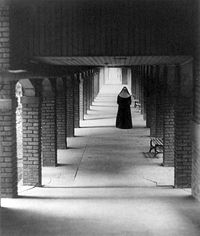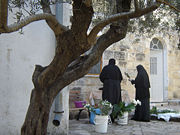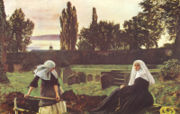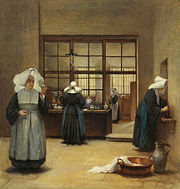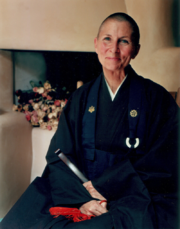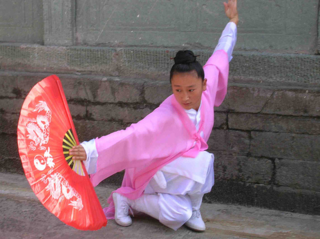Nun
2008/9 Schools Wikipedia Selection. Related subjects: Religious movements, traditions and organizations
A nun is a woman who has taken special vows committing her to a religious life. She may be an ascetic who voluntarily chooses to leave mainstream society and live her life in prayer and contemplation in a monastery or convent. The term "nun" is applicable to Roman Catholics, Eastern Christians, Anglicans, Lutherans, Jains, Buddhists, and Taoists, for example.
Christianity
Eastern Orthodox
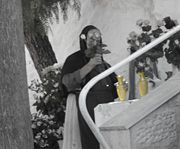
In the Eastern Orthodox Church there is no distinction between a monastery for women and a monastery for men. In Greek, Russian, and other Eastern European languages, both domiciles are called "monasteries" and the ascetics who live therein are "Monastics". In English, however, it is acceptable to use the terms "nun" and "convent" for clarity and convenience. The term for an abbess is the feminine form of abbot ( hegumen)—Greek: hegumeni; Serbian: Игуманија (Igumanija); Russian: игумения, ( igumenia). Orthodox monastics do not have distinct "orders" as in Western Christianity. Orthodox monks and nuns lead identical spiritual lives. There may be slight differences in the way a monastery functions internally but these are simply differences in style (Gr. typica) dependent on the Abbess or Abbot. The Abbess is the spiritual leader of the convent and her authority is absolute (no priest, bishop, or even patriarch can override an abbess within the walls of her monastery—she can, however, be removed from office by her ecclesiastical superiors). There has always been spiritual equality between men and women in the Orthodox Church ( Galatians 3:28). Abbots and Abbesses rank in authority equal to bishops in many ways and were included in ecumenical councils. However, unlike the West where monasteries were given independence from the local ordinary, Orthodox monasteries are always under a bishop or Synod of bishops. Abbesses hear confessions (but do not absolve) and dispense blessings on their charges, though they still require the services of a presbyter (i.e., a priest) to celebrate the Divine Liturgy and perform other priestly functions, such as the absolution of a penitent.
Orthodox monastics, in general have little or no contact with the outside world, especially family. The pious family whose child decides to enter the monastic profession understands that their child will become "dead to the world" and therefore be unavailable for marriage.
There are a number of different levels that the nun passes through in her profession:
- Novice—When one enters a monastery the first three to five years are spent as a novice. Novices may or may not (depending on the abbess's wishes) dress in the black inner robe ( Isorassa); those who do will also usually wear the apostolnik or a black scarf tied over the head (see photo, above). The isorassa is the first part of the monastic " habit" of which there is only one style for Orthodox monastics (this is true in general, there have been a few slight regional variations over the centuries, but the style always seems to precipitate back to a style common in the 3rd or 4th century). If a novice chooses to leave during the novitiate period no penalty is incurred.
- Rassaphore—When the abbess deems the novice ready, the novice is asked to join the monastery. If she accepts, she is tonsured in a formal service during which she is given the outer robe ( Exorassa) and veil ( Epanokamelavkion) to wear, and (because she is now dead to the world) receives a new name. Nuns consider themselves part of a sisterhood; however, tonsured nuns are usually addressed as "Mother" (in some convents, the title of "Mother" is reserved to those who enter into the next level of Stavrophore).
- Stavrophore—The next level for monastics takes place some years after the first tonsure when the abbess feels the nun has reached a level of discipline, dedication, and humility. Once again, in a formal service the nun is elevated to the "Little Schema" which is signified by additions to her habit of certain symbolic articles of clothing. In addition, the abbess increases the nun’s prayer rule, she is allowed a stricter personal ascetic practice, and she is given more responsibility.
- Great Schema—The final stage, called "Megaloschemos" or " Great Schema" is reached by nuns whose Abbess feels they have reached a high level of excellence. In some monastic traditions the Great Schema is only given to monks and nuns on their death bed, while in others they may be elevated after as little as 25 years of service.
- Stavrophore—The next level for monastics takes place some years after the first tonsure when the abbess feels the nun has reached a level of discipline, dedication, and humility. Once again, in a formal service the nun is elevated to the "Little Schema" which is signified by additions to her habit of certain symbolic articles of clothing. In addition, the abbess increases the nun’s prayer rule, she is allowed a stricter personal ascetic practice, and she is given more responsibility.
One difference between Roman Catholic and Orthodox nuns is that Orthodox do not have "active" communities with apostolates such as teaching or nursing, so Orthodox nuns do not leave the monastery unless they need to. However, care and concern for the poor, the sick and those in need have always been a charism of the monastic life, so just as Orthodox monasteries have never been "active" in the Roman Catholic sense, neither have they been completely "cloistered" or cut off from society.
Roman Catholic
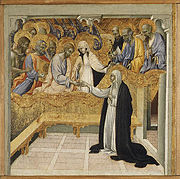
In Roman Catholicism, a nun is a female monastic who has taken solemn vows (the male equivalent is a "monk"). Nuns are cloisterred to the degree established by the rule of the religious institution they enter.
In the Roman Catholic tradition, there are a number of different orders of nuns each with its own charism or special character.
In general, when a woman enters a convent she first undergoes an initial period of testing the life, known as postulancy, for a period of six months to a year. If she, and the order, determine that she may have a vocation to the life, she receives the habit of the order (usually with some modification to distinguish her from professed nuns) and undertakes the novitiate, a period of living the life of a nun without yet taking vows that lasts one to two years.. Upon completion of this period she may take her initial, temporary vows. Temporary vows last one to three years, typically, and will be professed for not less than three years and not more than six. Finally, she will petition to make her "perpetual profession", taking permanent, solemn vows.
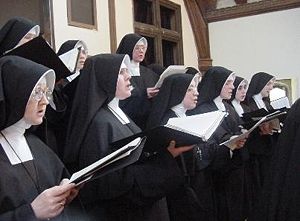
In the various branches of the Benedictine tradition (Benedictines, Cistercians, Camaldolese, and Trappists among others) nuns take vows of stability (that is, to remain a member of a single monastic community), obedience (to an abbess or prioress), and "conversion of life" (which includes the ideas of poverty and chastity). The " Poor Clares" (a Franciscan order) and those Dominican nuns who lived a cloistered life take the three-fold vows of poverty, chastity and obedience. Most orders of nuns not listed here follow one of these two patterns, with some orders taking an additional vow related to the specific work or character of their order (e.g., to undertake a certain style of devotion, praying for a specific intention or purpose).
Cloistered nuns observe "papal enclosure" rules and their monasteries typically have walls and grilles separating the nuns from the outside world. The nuns rarely leave (except for medical necessity, or occasionally for purposes related to their contemplative life) though they may have visitors in specially built parlors that allow them to meet with outsiders. They are usually self-sufficient, earning money by selling jams or candies or baked goods by mail order, or by making liturgical items (vestments, candles, bread for Holy Communion). They sometimes undertake contemplative ministries—that is, a monastery of nuns is often associated with prayer for some particular good or supporting the missions of another order by prayer (for instance, the Maryknoll order includes a monastery of cloistered nuns who pray for the work of the missionary priests, brothers and religious sisters; the Sister Disciples of the Divine Master are cloistered nuns who pray in support of the religious sisters of the Daughters of Saint Paul in their media ministry; the Dominican nuns of Corpus Christi Monastery in the Bronx, N.Y., pray in support of the priests of the Archdiocese of New York).
A nun who is elected to head her monastery is termed an abbess if the monastery is an abbey, a prioress if it is a priory, or more generically may be referred to as the Mother Superior and styled "Reverend Mother". The distinction between abbey and priory has to do with the terms used by a particular order or by the level of independence of the monastery. Technically, a convent is any home of a community of sisters—or, indeed, of priests and brothers, though this term is rarely used in the U.S. The term "monastery" is often used by communities within the Benedictine family, and "convent" (when referring to a cloister) is often used of the monasteries of certain other orders.
Distinction between nun and religious sister
In the Roman Catholic Church, the terms "nun" and "religious sister" have distinct meanings. Women belonging to communities like the Sisters of Charity, or Third Order Franciscans or Dominicans are religious sisters, not nuns. Nuns and sisters are distinguished by the type of vows they take ( solemn vows vs. simple vows) and the focus of their good works. The type of vows that are taken are dependent on the Constitutions and/or rule of each community, which are submitted for approval to the Congregation for Institutes of Consecrated Life and Societies of Apostolic Life, a body of the Roman Curia. The religious community of a nun is referred to as a " religious order" while the religious community of a sister is referred to as an "institute" or " congregation". Hence, all nuns are religious sisters, but not all religious sisters are, properly speaking, nuns.
To be a Roman Catholic nun, one must
- Live in a convent, cloister, or monastery;
- belong to an order in which the members eventually take the solemn vows; and
- recite the Liturgy of the Hours or other prayers together with her community.
Nuns are restricted from leaving the cloister, though some may engage in teaching or other vocational work depending on the strictness of enforcement. Visitors are not allowed into the monastery to freely associate with nuns. In essence, the work of a nun is within the confines of her monastery, while the work of a sister is in the greater world. Both sisters and nuns are addressed as "Sister".
There may be both nuns and sisters within a religious order. For instance, the Poor Clares (sometimes known as "Second Order Franciscans") are cloistered nuns following the Franciscan tradition, while the Sisters of St. Francis are among the many groups of "Third Order Franciscan Regulars" who exist to teach, work in hospitals or with the poor or perform other ministries; there are also groups of cloistered Dominican nuns, and groups of Dominican sisters who are dedicated to teaching or working with the sick.
Anglican Communion
Anglican religious orders are organizations of laity and/or clergy in the Anglican Communion who live under a common rule. The term "religious orders" must be distinguished from Holy Orders (the sacrament of ordination which bishops, priests, and deacons receive), though many communities do have ordained members.
The structure and function of religious orders in Anglicanism roughly parallels that which exists in Roman Catholicism. Religious communities are divided into orders proper, in which members take solemn vows and congregations, whose members take simple vows.
Religious communities throughout England were destroyed by King Henry VIII when he separated the Church of England from the papacy during the English Reformation (see Dissolution of the Monasteries). Monasteries were deprived of their lands and possessions, and monastics were forced to either live a secular life or flee the country.
With the rise of the Catholic Revival and the Oxford Movement in Anglicanism in the early 1800s came interest in the revival of "religious life" in England. Between 1841 and 1855, several religious orders for nuns were founded, among them the Community of St. Mary at Wantage and the Community of St. Margaret at East Grinstead.
In the United States and Canada, the founding of Anglican religious orders of nuns began in 1845 with the Sisterhood of the Holy Communion (now defunct) in New York.
In the Episcopal Church in the United States, there are two recognized types of religious communities, called Religious Orders and Christian Communities. The differences are as follows:
A Religious Order of this Church is a society of Christians (in communion with the See of Canterbury) who voluntarily commit themselves for life, or a term of years, to holding their possessions in common or in trust; to a celibate life in community; and obedience to their Rule and Constitution. (Title III, Canon 24, section 1)
A Christian Community of this Church is a society of Christians (in communion with the See of Canterbury) who voluntarily commit themselves for life, or a term of years, in obedience to their Rule and Constitution. (Title III, Canon 24, section 2)
In some Anglican orders, there are Sisters who have been ordained and can celebrate the Eucharist.
Other Christian
Some churches that are directly descended from the Reformation, such as Lutherans, and some Calvinists continue to have small monastic communities, though these generally play a much smaller role in religious practice than in Roman Catholic or Orthodox churches. Most Protestant monastic communities are not organized into formal orders.
Buddhism
|
People of the Pali canon |
|
| Pali | English |
|
Community of Buddhist Disciples |
|
| Monastic Sangha | |
|
Bhikkhu, Bhikkuṇī |
Monk, Nun |
| Laity | |
|
Upāsaka, Upāsikā |
Lay devotee (m., f.) |
|
Related Religions |
|
|
Samaṇa |
Wanderer |

All Buddhist traditions have nuns, although their status might be different in the various Buddhist countries. Fully ordained Buddhist nuns ( bhikkhunis) have more Patimokkha-rules than the monks ( bhikkhus). This is due to a greater need of protection of women in a patriarchal environment, in which ordination of women by the Buddha in historical times (500 BC) must be seen as almost revolutionary. The important vows are the same, however.
There are quite a lot of variation in nuns' dress and social conventions between different Buddhist cultures in Asia.
Both nuns and monks are highly respected in Buddhist countries. Both groups sometimes perform ceremonies or rituals for lay people. Nuns and monks alike can advance spiritually on the path and then become a Buddhist teacher -- e.g. a 'lama'.
Thailand
In Thailand, a country which never had a tradition of fully-ordained nuns ( bhikkhuni), there developed a separate order of non-ordained female renunciates called Mae Ji. At the beginning of the 21st century some Buddhist women in Thailand have started to introduce the bhikkhuni sangha in their country as well, even if public acceptance is still lacking . Venerable Dhammananda ( Thai: ธัมมนันทาี), , the former successful academic scholar Dr. Chatsumarn Kabilsingh, established a controversial monastery for the training of Buddhist nuns in Thailand.
Tibet
The August 2007 International Congress on Buddhist Women's Role in the Sangha, with the support of H. H. XIVth Dalai Lama, is expected to reinstate the Gelongma (skt. Bikshuni, tib. Gelongma) lineage, having been lost, in India and Tibet, for centuries. It is currently only possible for women to take Rabjungma ('entering') and Getshülma ('novice') ordinations in Tibetan tradition. Gelongma ordination requires the presence of ten fully ordained people keeping the exact same vows (men's and women's vows differ slightly). Because 10 Gelongmas are required in order to ordain a new Gelongma, the effort to reinstate the Gelongma tradition has taken a long time.
It is permissible for a Tibetan nun to receive Bikshuni ordination from another living tradition, e.g. in Vietnam. Based on this, Western nuns ordained in Tibetan tradition, like Venerable Thubten Chodron, took full ordination in another tradition, in order to revive 'Gelongma' ordination. The same socio-cultural reasons that make it difficult for women to be nuns will still present challenges to the first Tibetan Gelongmas.
The ordination of monks and nuns in Tibetan Buddhism distinguishes three stages (rabjung(ma), getshül(ma), and gelong(ma)). The clothes of the nuns in Tibet are basically the same with those of monks, but there are differences between novice and gelong robes.
Fiction and dramatizations featuring nuns
Nuns play an important role in the public's imagination. The following list, of works with Wikipedia articles where nuns play a major part, ranges from A Time for Miracles which is literally hagiography to realistic accounts by Kathryn Hulme and Monica Baldwin to the blatant nunsploitation of Sacred Flesh. All the works use Catholic nuns save Black Narcissus (Anglicans). All are outsiders' views with the exceptions of Dead Man Walking based on an autobiography by Helen Prejean, Monica Baldwin, and The Nun's Story, based on the book by Kathryn Hulme relating the experiences of lapsed nun Marie-Louise Habets.
|
|
